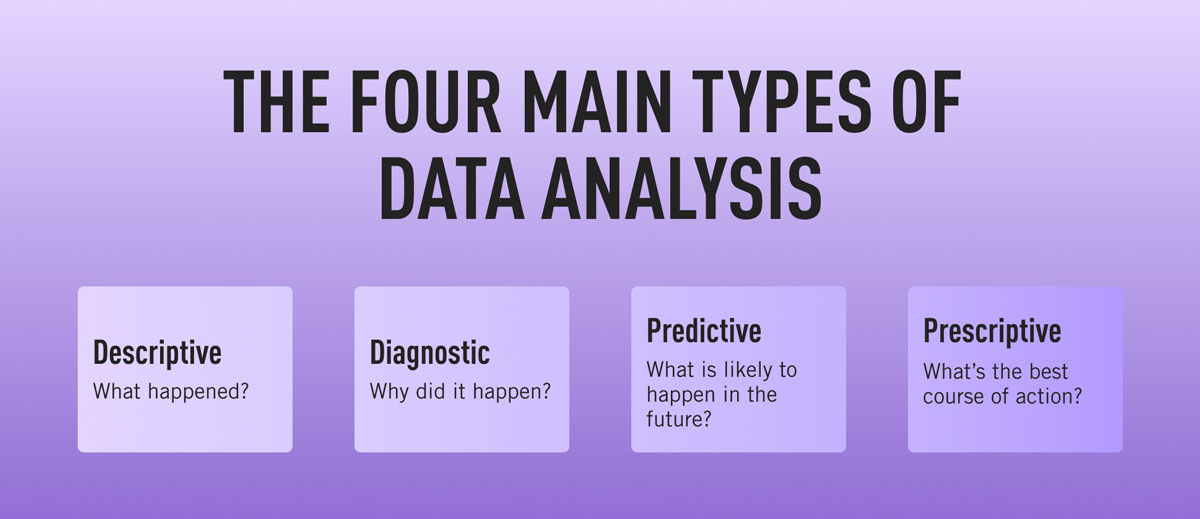When presented with new data, the first step a data analyst must take is always to understand what story it’s trying to tell. Data analytics is a complex beast, however, involving many different tools and analytical approaches. So which one should you use?
If you’re new to data and want to learn the basics, descriptive analytics is a good place to start. But what exactly is descriptive analytics, and how does it work? In this post, we’ll dive deep on the topic, answering all your questions, including:
- How does descriptive analytics work?
- How is descriptive analytics used?
- Advantages of descriptive analytics
- Disadvantages of descriptive analytics
- Descriptive analytics use cases
- Key takeaways
Ready to get the low-down on descriptive analytics? Let’s dive in.

1. How does descriptive analytics work?
Of all data analytics techniques, descriptive analytics is perhaps the most straightforward. It involves parsing (or breaking down) data and summarizing its main features and characteristics. In this way, descriptive analytics presents what has happened in the past without exploring why or how.
Because it is merely explanatory, descriptive analytics uses basic descriptive statistics. This includes measures of distribution (frequency or count), central tendency (mean, mode, and median), and variability (such as variance and standard deviation). Where relevant, it also measures the position of various data points, including the interquartile or percentile range.
Descriptive analytics often presents its findings using reports, pivot tables, and visualizations like histograms, line graphs, pie charts, and box and whisker plots. We won’t explore these further here, but you can learn more about descriptive statistics in this post.
2. How is descriptive analytics used?
Data analysts can use descriptive statistics to summarize more or less any type of data, although it helps to think of it as the first step in a more protracted process. That’s because while descriptive statistics may describe trends or patterns, it won’t dig deeper. For this, we need tools like diagnostic and predictive analytics. Nevertheless, descriptive analytics is exceptionally useful for introducing yourself to unknown data.
The following kinds of data can all be summarized using descriptive analytics:
- Financial statements
- Surveys
- Social media engagement
- Website traffic
- Scientific findings
- Weather reports
- Traffic data
The list goes on! Essentially, any data set can be summarized in one way or another, meaning descriptive analytics has an almost endless number of applications. We’ll explore these in more depth in section five. First, let’s look at some of the benefits and drawbacks of descriptive analytics.
3. Advantages of descriptive analytics
Although relatively simplistic as analytical approaches go, descriptive analytics nevertheless has many advantages. Descriptive analytics:
- Presents otherwise complex data in an easily digestible format.
- Provides a direct measure of the incidence of key data points.
- Is inexpensive and only requires basic mathematical skills to carry out.
- Is faster to carry out, especially with help from tools like Python or MS Excel.
- Relies on data that organizations already have access to, meaning there’s no need to source additional data.
- Looks at a complete population (rather than data sampling), making it considerably more accurate than inferential statistics.
But, of course, being so straightforward means descriptive analytics also has its limitations. Let’s explore some of these next.
4. Disadvantages of descriptive analytics
Okay, we’ve looked at the strengths of descriptive analytics—but where does it fall short? Some disadvantages of descriptive analytics include:
- You can summarize data sets you have access to, but these may not tell a complete story.
- You cannot use descriptive analytics to test a hypothesis or understand why data present the way they do.
- You cannot use descriptive analytics to predict what may happen in the future.
- You cannot generalize your findings to a broader population.
- Descriptive analytics tells you nothing about the data collection methodology, meaning the data set may include errors.
As you may suspect, although descriptive analytics are useful, it’s important not to overstretch their capabilities. Fortunately, we have diagnostic and predictive analytics to help fill in the gaps where descriptive analytics falls short.
5. Descriptive analytics use cases
Now we’ve covered the theory around descriptive analytics, how can it be used in the real world? While descriptive analytics only focuses on what has happened, not why, it remains a valuable first step in the broader data analytics process. Let’s take a look.
Tracking social media engagement
Social media is a key touchpoint along the sales journey. The ability to measure and present engagement metrics across a complex constellation of campaigns and social networks is, therefore, vital for determining the most successful approaches to digital marketing. Fortunately, marketing reports on social media engagement will include descriptive analytics by default. Clicks, likes, shares, detail expands, bounce rates, and so on are all measures of social media engagement that can be easily summarized using descriptive techniques.
For instance, perhaps a company is interested in knowing which social media account is driving the most traffic to their website. Using descriptive statistics, visualizations, and dashboards, they can easily compare information about different channels. Similarly, marketing teams can look at specific shareable content, perhaps comparing videos with blog posts, to see which results in the most clicks.
While none of this information draws direct conclusions (in that it doesn’t measure cause and effect) it’s still valuable. It helps teams to devise hypotheses or make informed guesses about where to invest their time and budget.
Streaming and e-commerce
Subscription streaming services like Spotify and Netflix, and e-commerce sites like Amazon and eBay all use descriptive analytics to identify trends. Descriptive measures help determine what’s currently most popular with users and buyers. Spotify, for example, uses descriptive analytics to learn which albums or artists subscribers are listening to. Meanwhile, Amazon uses descriptive analytics to compare customer purchases. In both cases, these insights inform their recommendation engines.
Netflix, meanwhile, takes this use of descriptive analytics even further. A highly data-driven company, Netflix uses descriptive analytics to see what genres and TV shows interest their subscribers most. These insights inform decision-making in areas from new content creation to marketing campaigns, and even which production companies they work with.
Learning management systems
From traditional education to corporate training, many organizations and schools now use online/offline hybrid learning. Learning management systems (or LMSs for those in the know!) are a ubiquitous part of this. LMS platforms track everything from user participation and attendance to test scores, and—in the case of e-learning courses—even how long it takes learners to complete. Summarizing this information, descriptive-analytical reports offer a high-level overview of what’s working and what’s not.
Using these data, teachers and training providers can track both individual and organization-level targets. They can analyze grade curves, or see which teaching resources are most popular. And while they won’t necessarily know why, it may be possible to infer from the data that videos, for example, are more popular than, say, written documents. Presenting this information is the first step towards improving course design and creating better learner outcomes.
6. Key takeaways
This post has offered a full introduction to descriptive analytics. We’ve learned that:
- Descriptive analytics is the simplest form of data analysis, and involves summarizing a data set’s main features and characteristics.
- Descriptive analytics relies on statistical measures of distribution, central tendency, and variability.
- It provides an overview of varied data types, from financial statements to surveys, website traffic, and scientific data.
- A key advantage of descriptive analytics is that it requires only basic math skills and allows you to present otherwise complex data in an easily digestible format.
- The main disadvantage of descriptive analytics is that it only summarizes data; it doesn’t draw conclusions or test hypotheses.
- We can use descriptive analytics to measure things like social media engagement, content curation, and learner outcomes.
To learn more about data analytics, or to try some test exercises, why not sign up for this free, 5-day data analytics short course? You can also supplement your knowledge with the following introductory topics:
